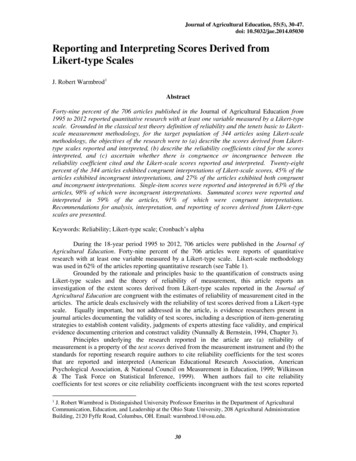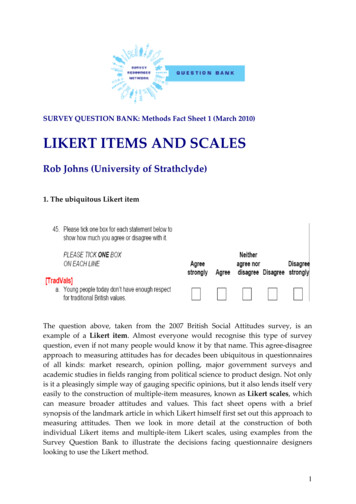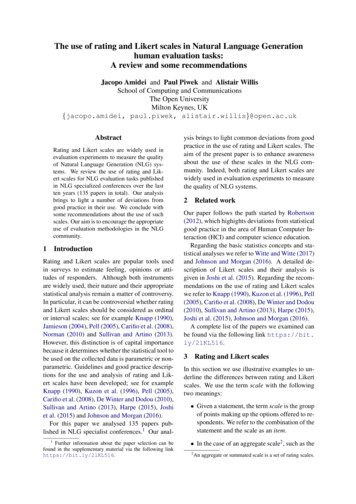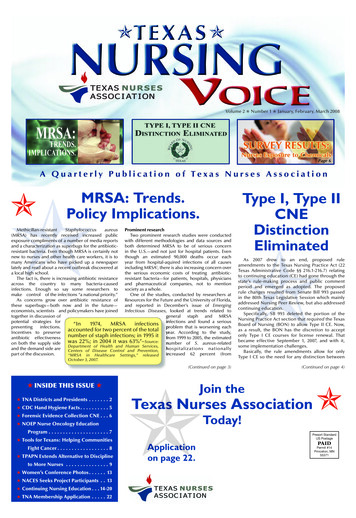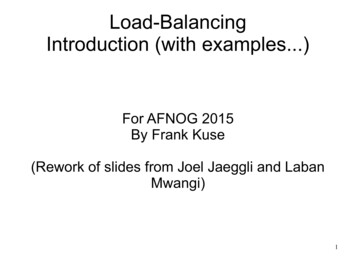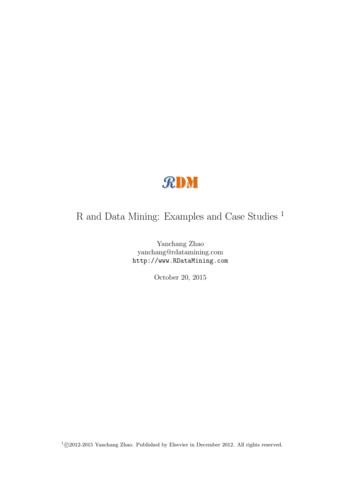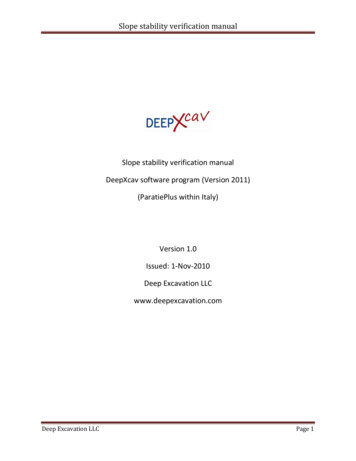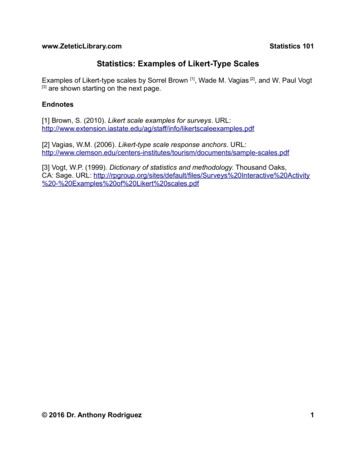
Transcription
www.ZeteticLibrary.comStatistics 101Statistics: Examples of Likert-Type ScalesExamples of Likert-type scales by Sorrel Brown [1], Wade M. Vagias [2], and W. Paul Vogt[3]are shown starting on the next page.Endnotes[1] Brown, S. (2010). Likert scale examples for surveys. /likertscaleexamples.pdf[2] Vagias, W.M. (2006). Likert-type scale response anchors. ism/documents/sample-scales.pdf[3] Vogt, W.P. (1999). Dictionary of statistics and methodology. Thousand Oaks,CA: Sage. URL: %20scales.pdf 2016 Dr. Anthony Rodriguez1
Likert Scale Examples for SurveysSorrel BrownANR Program EvaluationIowa State University Extensionsorrel@iastate.eduDec 2010AGREEMENT Strongly AgreeAgreeUndecidedDisagreeStrongly Disagree Agree StronglyAgree ModeratelyAgree SlightlyDisagree SlightlyDisagree ModeratelyDisagree Strongly AgreeDisagreeorAgreeUndecidedDisagree Agree Very StronglyAgree StronglyAgreeDisagreeDisagree StronglyDisagree Very Strongly Completely AgreeMostly AgreeSlightly AgreeSlightly DisagreeMostly DisagreeCompletely Disagree Disagree StronglyDisagreeSlightly DisagreeSlightly AgreeAgreeAgree StronglyVALUE HighModerateLowNone RELEVANCEExcellentSomewhatPoorFREQUENCY Very FrequentlyFrequentlyOccasionallyRarelyVery RarelyNever AlwaysVery FrequentlyOccasionallyRarelyVery RarelyNever AlwaysUsuallyAbout Halfthe TimeSeldomNever A Great DealMuch OftenSometimes Almost AlwaysTo a Considerable Degree AlwaysVery OftenSometimesRarelyNever
SomewhatLittleNeverSeldomNever OccasionallySeldomIMPORTANCE Very ImportantImportantModerately ImportantSlightly ImportantNot Important 0 Not Important At All1 Of Little Importance2 Of AverageImportance3 Very Important4 Absolutely EssentialVery ImportantModerately ImportantNot ImportantQUALITY Very GoodGoodAcceptablePoorVery Poor Very PoorBelow AverageAverageAbove AverageExcellent GoodFairPoorLIKELIHOOD Like MeNot Like Me To a Great ExtentSomewhatVery LittleNot at All DefinitelyVery ProbablyProbablyPossiblyProbably NotDefinitely Not Almost Always TrueUsually TrueOften TrueOccasionally TrueRarely TrueUsually Not TrueAlmost Never True TrueFalseNot likelySomewhat likelyVery likelyDichotomous Scales:FairUnfairThree-Point Scales:AgreeDisagreeTrueFalseYesNo
More than I would likeAbout rightLess than I would likeToo HarshAbout rightToo LenientToo StrictAbout rightToo LenientToo heavyAbout RightToo lightToo muchAbout rightToo littleExtremelyModeratelyNot at allFour-Point Scales:Most of the timeSome of the timeSeldomNeverStrongly AgreeAgreeDisagreeStrongly DisagreeDefinitely won’tProbably won’tProbably willDefinitely willFive-Point Scales:Much betterSomewhat betterStayed the sameSomewhat worseMuch worseStrongly AgreeAgreeUndecidedDisagreeStrongly DisagreeVery HighAbove AverageAverageBelow AverageVery LowExcellentAbove AverageAverageBelow AverageVery PoorVery goodGoodFairPoorVery poorMuch higherHigherAbout the sameLowerMuch lowerAlmost telySlightlyNot at allVery satisfiedSatisfiedNeitherDissatisfiedVery dissatisfiedVery importantImportantFairly importantSlightly importantNot importantSeven-Point Scales:
very dissatisfiedmoderately dissatisfiedslightly dissatisfiedneutralslightly satisfiedmoderately satisfiedvery satisfiedfar belowmoderately belowslightly belowmet expectationsslightly abovemoderately abovefar abovevery poorpoorfairgoodvery goodexcellentexceptional
Likert-Type Scale Response AnchorsCitation:Vagias, Wade M. (2006). Likert-type scale response anchors. Clemson International Institute for Tourism& Research Development, Department of Parks, Recreation and Tourism Management. ClemsonUniversity.Level of Acceptability 1 – Totally unacceptable 2 – Unacceptable 3 – Slightly unacceptable 4 – Neutral 5 – Slightly acceptable 6 – Acceptable 7 – Perfectly AcceptableLevel of Appropriateness 1 – Absolutely inappropriate 2 – Inappropriate 3 – Slightly inappropriate 4 – Neutral 5 – Slightly appropriate 6 – Appropriate 7 – Absolutely appropriateLevel of Importance 1 – Not at all important 2 – Low importance 3 – Slightly important 4 – Neutral 5 – Moderately important 6 – Very important 7 – Extremely importantLevel of Agreement 1 – Strongly disagree 2 – Disagree 3 – Somewhat disagree 4 – Neither agree ordisagree 5 – Somewhat agree 6 – Agree 7 – Strongly agreeKnowledge of Action 1 – Never true 2 – Rarely true 3 – Sometimes butinfrequently true 4 – Neutral 5 – Sometimes true 6 – Usually true 7 – Always trueReflect Me? 1 – Very untrue of me 2 – Untrue of me 3 – Somewhat untrue of me 4 – Neutral 5 – Somewhat true of me 6 – True of me 7 – Very true of meMy beliefs 1 – Very untrue of what I believe 2 – Untrue of what I believe 3 – Somewhat untrue of what Ibelieve 4 – Neutral 5 – Somewhat true of what Ibelieve 6 – True of what I believe 7 – Very true of what I believePriority: 1 – Not a priority2 – Low priority3 – Somewhat priority4 – Neutral5 – Moderate Priority6 – High priority7 – Essential priorityLevel of Concern 1 – not at all concerned 2 – Slightly concerned 3 – Somewhat concerned 4 – Moderately concerned 5 – Extremely concernedPriority Level 1 – Not a priority 2 – Low priority 3 – Medium priority 4 – High priority 5 – EssentialLevel of Support/Opposition 1 – Strongly oppose 2 – Somewhat oppose 3 – neutral 4 – Somewhat favor 5 – Strongly favorLevel of Probability 1 – Not probable 2 – Somewhat improbable 3 – Neutral 4 – Somewhat probable 5 – Very probableLevel of Agreement 1 – Strongly disagree 2 – Disagree 3 – Neither agree or disagree 4 – Agree 5 – Strongly agreeLevel of Desirability 1 – Very undesirable 2 – Undesirable 3 – neutral 4 – Desirable 5 – Very desirableLevel of Participation 1 – No, and not considered 2 – No, but considered 3 – YesLevel of Problem 1 – Not at all a problem 2 – Minor problem 3 – Moderate problem 4 – Serious problemFrequency – 5 point 1 – Never 2 – Rarely 3 – Sometimes 4 – Often 5 – AlwaysAffect on X 1 – No affect 2 – Minor affect 3 – Neutral 4 – Moderate affect 5 – Major affectFrequency 1 – Never 2 – Rarely 3 – Occasionally 4 – A moderate amount 5 – A great dealLevel of Consideration 1 – Would not consider 2 – Might or might not consider 3 – Definitely considerFrequency of Use 1 – Never 2 – Almost never 3 – Occasionally/Sometimes 4 – Almost every time 5 – Every time
Frequency – 7 point 1 – Never 2 – Rarely, in less than 10%of the chances when I couldhave 3 – Occasionally, in about30% of the chances when Icould have 4 – Sometimes, in about50% of the chances when Icould have 5 – Frequently, in about 70%of the chances when I couldhave 6 – Usually, in about 90% ofthe chances I could have. 7 – Every timeAmount of Use 1 – Never use 2 – Almost never 3 – Occasionally/Sometimes 4 – Almost every time 5 – Frequently useLevel of Familiarity 1 – not at all familiar 2 – Slightly familiar 3 – Somewhat familiar 4 – Moderately familiar 5 – Extremely familiarLevel of Awareness 1 – not at all aware 2 – Slightly aware 3 – Somewhat aware 4 – Moderately aware 5 – Extremely awareLevel of Difficulty 1 – Very difficult 2 – Difficult 3 – Neutral 4 – Easy 5 – Very easyLevel of Satisfaction – 5 point 1 – Not at all satisfied 2 – slightly satisfied 3 – moderately satisfied 4 – Very satisfied 5 – Extremely satisfiedLikelihood 1 – Extremely unlikely 2 – unlikely 3 – Neutral 4 – likely 5 – Extremely likelyLevel of Satisfaction – 7 point 1 – Completely dissatisfied 2 – Mostly dissatisfied 3 – Somewhat dissatisfied 4 – neither satisfied ordissatisfied 5 – Somewhat satisfied 6 – Mostly satisfied 7 – Completely satisfiedLevel of Detraction 1 – detracted very little 2– 3 – Neutral 4– 5 – Detracted very muchGood / Bad 1 – Very negative 2– 3 – Neutral 4– 5 – Very positiveBarriers 1 – Not a barrier2 – Somewhat of a barrier3 – Moderate barrier4 – Extreme barrierLevel of Satisfaction – 5 point 1 – Very dissatisfied 2 – dissatisfied 3 – unsure 4 – satisfied 5 – Very satisfiedLevel of Quality – 5 point 1 – Poor 2 – Fair 3 – Good 4 – Very good 5 – ExcellentComparison of Two Products 1 – much worse 2 – somewhat worse 3 – about the same 4 – somewhat better 5 – much betterLevel of Responsibility 1 – Not at all responsible 2 – somewhat responsible 3 – mostly responsible 4 – completely responsibleLevel of Influence 1 – not at all influential 2 – slightly influential 3 – somewhat influential 4 – very influential 5 – extremely influential
Examples of Likert Scaled Responses Used in Data-GatheringA variety of methods are available to assist evaluators in gathering data. One of those methodsinvolves the use of a scale. One of the most common scale types is a Likert scale.A Likert scale is commonly used to measure attitudes, knowledge, perceptions, values,and behavioral changes. A Likert-type scale involves a series of statements that respondentsmay choose from in order to rate their responses to evaluative questions (Vogt, 1999).Too littleOK as isToo muchIneffectiveUncertainEffectiveNot usefulSome impactUsefulWill not do itUndecidedWill do itDefinitely notUndecidedDefinitely willNot essentialMakes no differenceImperativeNoMaybeYesNot at allVery littleSomeVery hardHardNeither hard nor irGoodVery goodNot importantSomewhat importantImportantVery importantNoneA littleQuite a bitCompletelyNot awareSomewhat awareUsually awareVery much awareNot knowledgeableaboutSomewhatknowledgeable aboutKnowledgeable aboutVery knowledgeableabout
StronglydisagreeDisagreeNo opinion oruncertainAgreeStrongly agreeVery poorPoorAverageGoodExcellentNo valueLimited valueAverage valueMuch valueExtreme valueVery poorlyPoorlyAdequatelyWellVery wellNot valuableLimited valueAverage valueValuableVery valuableVery much belowaverageBelow averageAverageAbove averageVery muchabove averageInferiorNot goodAcceptableGoodSuperiorVery inferiorInferiorAverageSuperiorVery superiorWould not tryPoorlyAcceptablyWellVery wellVery unhappyUnhappyCan take it orleave itSatisfiedHighly satisfiedVery poorPoorFairGoodVery goodNot competentSomewhatcompetentUncertainCompetentHighly competentFalseMore false thantrueIn betweenMore true thanfalseTrueHardly everOccasionallySometimesFrequentlyAlmost alwaysMuch less thanmostLess than mostAbove averageMore than mostMuch more thanmostPoorFairNo opinionGoodExcellentVery badBadAverageGoodVery goodVery ineffectiveIneffectiveAverageEffectiveVery effectiveVery slowSlowAverageFastVery fastPoorUnremarkableMeetsexpectationsBetter thanexpectedOutstandingExcellentVery goodSatisfactoryVery poorUnacceptable
Decrease greatlyDecrease slightlyStay the sameIncrease slightlyIncrease greatlyVery lowLowModerateHighVery high4Great importance5Little importance123ExtremelydullVery dullFairly dullSo-soFairlyinterestingVeryinterestingNot at allVery littleFairly wellQuite wellVery onallyfavorableExcellentVery goodGoodSatisfactory PoorVery poorUnacceptableVogt, W. Paul (1999). Dictionary of statistics and methodology. Sage: Thousand Oaks,California.
A variety of methods are available to assist evaluators in gathering data. One of those methods involves the use of a scale. One of the most common scale types is a Likert scale. A Likert scale is commonly used to measure attitudes, knowledge, perceptions, values, and behavioral changes. A Likert-type scale involves a series of statements that respondents may choose from in order to rate their .
